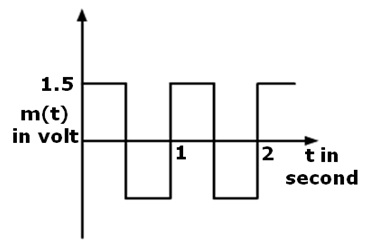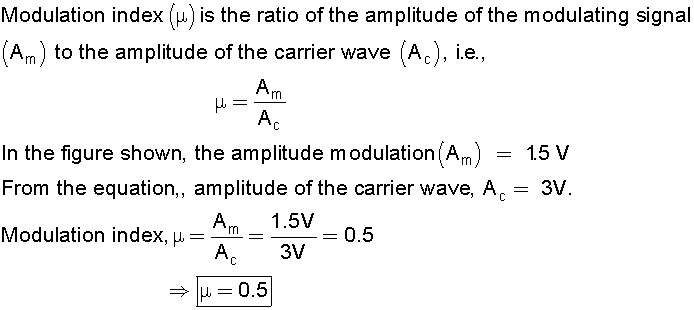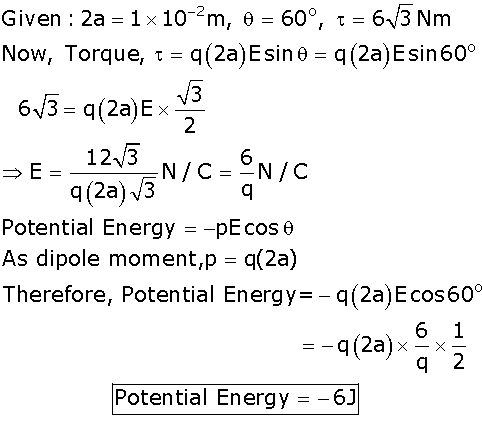CBSE Delhi-Set-3-2014
To Access the full content, Please Purchase
-
Q1
Define the term 'drift velocity' of charge carriers in a conductor and write its relationship with the current flowing through it.
Marks:1View AnswerAnswer:
Drift velocity (vd):
It is defined as the average velocity with which free electrons get drifted towards the positive end of the conductor under the influence of an external electric field applied. The drift velocity of electrons is of the order of 10-4ms-1.
The relationship of drift velocity with current is given by

Where, I = current following through the conductor,
n = number of density of free electrons,
A = area of cross section of the conductor and
e = charge of an electron.
-
Q2
The carrier wave of a signal is given by
 volt. The modulating signal is a square wave as shown. Find its modulation index.
volt. The modulating signal is a square wave as shown. Find its modulation index.
 Marks:1View Answer
Marks:1View AnswerAnswer:

-
Q3
Write the expression, in a vector form, for the Lorentz magnetic force
 due to a charge moving with velocity
due to a charge moving with velocity  in a magnetic field
in a magnetic field  . What is the direction of the magnetic force?Marks:1View Answer
. What is the direction of the magnetic force?Marks:1View AnswerAnswer:

-
Q4
Plot a graph showing variation of current versus voltage for the material GaAs.
Marks:1View AnswerAnswer:
Variation of current versus voltage for GaAs

The strong non-linear variation between current and voltage occurs in a material of GaAs. After a certain voltage, the current decreases as voltage increases, i.e., the effective resistance is negative. -
Q5
A convex lens is placed in contact with a plane mirror. A point object at a distance of 20 cm on the axis of this combination has its image coinciding with itself. What is the focal length of the lens?
Marks:1View AnswerAnswer:
Here, the convex lens is in contact with a plane mirror and an axial point object is placed at O at a distance OC = 20 cm.
As the image I of the object coincides with O, the rays refracted first from the lens and then reflected by the plane mirror must retrace their path. This can be possible, when the refracted rays fall normally on the mirror, i.e., the refracted rays from a beam parallel to principal axis of the lens. Hence, the object O must be at the focus of the convex lens.

-
Q6
The figure given below shows the block diagram of a generalized communication system. Identify the element labeled 'X' and write its function.
 Marks:1View Answer
Marks:1View AnswerAnswer:
Block diagram of a generalized communication system:

The element labelled 'X' in the figure is called 'channel'. The function of channel is to connect the transmitter and receiver. The signal from the transmitter is carried to the receiver by the communicating channel. A channel may be in the form of wires or wireless.
-
Q7
Two spherical bobs, one metallic and the other of glass, of the same size are allowed to fall freely from the same height above the ground. Which of the two would reach earlier and why?
Marks:1View AnswerAnswer:
A glass bob is non-conducting, while a metallic bob is conducting. Due to the non-conducting nature of the glass bob, it will only experience the Earth's gravitational pull and hence will reach earlier.
As metallic bob has conducting nature, eddy current is induced in it when falls through the magnetic field of the Earth. By Lenz's law, the current induced is such that it opposes the motion of the metallic bob. The metallic bob will experience a force in the upward direction which will slow down its speed to some extent; hence, metallic bob will reach the Earth after the glass bob. -
Q8
"For any charge configuration, equipotential surface through a point is normal to the electric field." Justify.
Marks:1View AnswerAnswer:
Equipotential surface is that surface at every point of which electric potential is same.
Imagine two points A1 and A2 on one surface. If V1 and V2 be the potentials at points A1 and A2 respectively then,
V1 = V2 or V1 – V2 = 0.
As the potential difference between any two points is the work done in taking a unit positive charge from one point to other is zero, hence it can be concluded that no work will be done if charge is moved from one point to other along an equipotential surface. This is only possible if line of force is perpendicular to such surface.
-
Q9
An electric dipole of length 1 cm, which is placed with its axis making an angle of 60° with uniform electric field, experience a torque of
 . Calculate the potential energy of the dipole if it has charge
. Calculate the potential energy of the dipole if it has charge  Marks:2View Answer
Marks:2View AnswerAnswer:

-
Q10
State the underlying principle of a cyclotron. Write briefly how this machine is used to accelerate charged particles to high energies.
Marks:2View AnswerAnswer:
Cyclotron Principle: In cyclotron, an oscillating electric field is used to accelerate positively charged particle to high energy in presence of strong magnetic field.
Construction and working: It consists of two hollow metallic cylindrical chambers shaped like the letter D, hence these chambers called as Dees ie D1 and D2. The D’s are separated slightly along their diameters and these Dees are enclosed in an evacuated chamber. A very high frequency and high voltage oscillator is connected to these Dees. A source of positive ions is placed between the poles of electromagnet.

The positive ion is getting attracted towards negatively charged D due to electrostatic attraction, when the alternating current shifts from positive terminal to the negative terminal, the positive ions moves in the upper D. The ions follow a circular path and as they gain energy, their rotational radius increases and the ion spiral out from the Dees. The deflector plate helps to take the ion out and the ions are allowed to hit a target or a nucleus to bring about a nuclear reaction. Square wave electric fields are used to accelerate the charged particles in a cyclotron.




